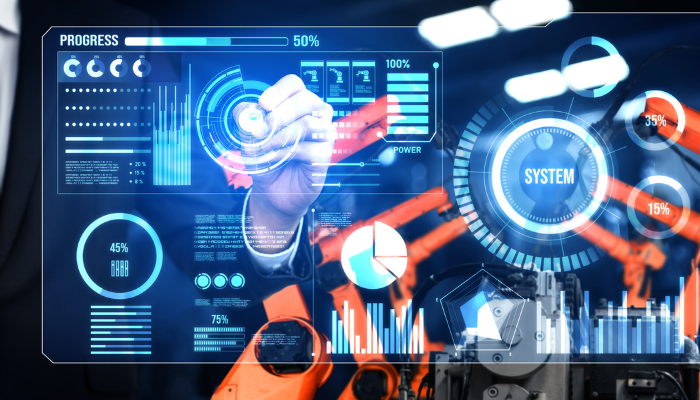“Necessity is the mother of invention,” so the saying goes. But what if invention could be the mother of necessity? What if we could spark innovation, not just to solve problems but to create opportunities?
Enter generative AI in product development, a powerful tool revolutionizing innovation. By generating creative text formats, code, images, music, videos, and other content, AI is unlocking new possibilities for product development.
Think about being able to test out tons of different ideas quickly. With generative AI, you can create countless variations of a product in no time. This means faster innovation and better products. McKinsey even found that AI-powered innovation can boost productivity by up to 40%!
In this blog, we’ll delve into the exciting world of generative AI for product development and explore how it’s transforming the field. We’ll discuss real-world applications, best practices, and the future of this groundbreaking technology.
Transforming Product Development with Generative AI: Redefining What’s Possible
Generative AI in product development is a type of artificial intelligence that creates new content and ideas, from text to images, music, code, and more. Unlike traditional AI, which follows predefined instructions, generative AI learns patterns and generates fresh, unique outputs. Think of it as a creative partner for your team, helping them explore endless possibilities quickly and efficiently.
How Generative AI Works in Product Development
Generative AI is revolutionizing how products are developed by assisting teams in creating new ideas, designs, and solutions. Unlike traditional AI, which follows strict rules, generative AI learns from data and generates unique, creative outputs.
Here’s how generative AI for product development works and benefits the process:
1. Learning from Data
Generative AI for product development starts by examining large amounts of data, like customer feedback, product trends, or market research. It identifies patterns and uses them to create new, relevant ideas or designs. The more data it processes, the better it understands what works.
2. Creating New Ideas and Designs
Once it’s learned from the data, generative AI in product development can come up with brand-new ideas. Whether it’s design variations, features, or even entire product concepts, generative AI can put together options you might not have thought of. It’s like having a brainstorming partner that never runs out of ideas!
3. Rapid Prototyping and Testing
Want to test a new design? Generative AI for product development can quickly generate multiple versions of it in minutes. This means you can try out several ideas at once and find the best one without waiting for long periods. It’s like skipping the slow process of making prototypes by hand and getting straight to the good stuff.
4. Optimizing Designs
Generative AI for product development isn’t just about creating designs—it’s also about refining them. It can suggest changes to make your product cheaper to produce, easier to use, or better suited to customer needs. This helps you achieve the best version of your product with less effort.
5. Predicting Market Needs
Generative AI can also look at data from past products and predict what customers might want next. It analyzes trends and behaviors, giving you a heads-up on what features to focus on or what gaps exist in the market. This way, you’re designing with the future in mind.
6. Continuous Improvement
The cool thing about generative AI in product development is that it doesn’t stop once the product is developed. It keeps learning from new data and improving designs, features, and ideas. This helps your product stay fresh and competitive in a fast-changing market.
It’s like we’ve got a backstage pass into the future of product creation—let’s dive into some real-world applications that showcase its impact!
Key Applications of Generative AI in Product Development
Generative AI is revolutionizing the way we approach product development. From ideation to market launch, AI-powered tools are streamlining processes and driving innovation.
Let’s explore these applications one by one:
1. Accelerated Ideation and Concept Development
Have you ever wished you could brainstorm with a team of super-creative robots? Well, thanks to generative AI in product development, that dream is becoming a reality! This incredible technology is shaking up the world of product design, making the process faster, more creative, and more customer-focused.
Think of it as a turbocharged brainstorming buddy that’s always ready with fresh ideas. You get a range of options fast, letting you zero in on what really works without starting from scratch.
How Does Generative AI Help in Product Development?
Let’s break down how this tech really gets things moving:
- Quick Idea Generation:
Generative AI for product development tools can analyze past designs and market trends to suggest different concepts in seconds. Instead of sketching out ideas by hand, you can instantly review several pre-made options. It’s all about speeding up decisions and getting right to the good stuff.
Example: Imagine you’re a car designer. Using generative AI, you can instantly see various model concepts with unique shapes and features. This way, you can identify the best design elements right from the start.
- Digital Prototypes Right Away:
Generative AI can make digital models that give you a realistic look at your product without needing a physical prototype. You get an early sneak peek at how it’ll work and what might need tweaking, saving both time and resources.
Example: Say you’re designing phone cases. With AI-generated digital prototypes, you can test durability and style virtually, helping you refine designs before manufacturing. It’s a shortcut that lets you address issues early.
- Personalized, Customer-Friendly Designs:
Generative AI in product development even helps you create products that resonate with customers by analyzing feedback and trends. This means you’re developing designs that are more likely to connect with your audience right from the get-go.
Example: A furniture company might use AI to review customer feedback and create chairs that align with current tastes. This way, they’re offering something people actually want.
Why Should You Use It?
Generative AI is a game-changer for product development because:
- It’s Fast: You can move through the design and testing phases much faster, getting your product to market sooner.
- It’s Creative: With AI, you’re not limited to the usual design ideas. You can experiment and find unique solutions quickly.
- It’s Customer-Focused: When AI helps you design based on what customers want, you’re more likely to launch a product that’s a hit.
And just when you thought it couldn’t get any cooler, let’s dive into how AI is changing the game with automated design and visual prototyping!
2. Automated Design and Visual Prototyping
Generative AI in product development is revolutionizing the process by taking on design tasks and creating lifelike prototypes. With automated design and visual prototyping, you can speed up the process and gain a clear, precise view of your product’s potential.
Here’s how generative AI reshapes the design and prototyping process:
How Generative AI Supports Automated Design and Visual Prototyping
- Multiple Design Options in Seconds
Generative AI can take your initial concept and generate multiple design variations in moments. This lets you review different styles and layouts quickly, skipping the usual long back-and-forth process.
Example: An eyewear company might enter a few design details into an AI tool and instantly receive dozens of unique frame styles, helping them pick the best look faster.
- Flexible Adjustments and Customizations
Need to tweak a design? Generative AI allows for rapid adjustments, whether it’s changing the color scheme or resizing elements. This flexibility supports quick experimentation and refinement.
Example: A furniture company could use AI to test out a sofa in different colors, fabrics, and finishes. Within minutes, they’d have ready-to-review options.
- Detailed 3D Models for Realistic Previews
Beyond simple sketches, generative AI for product development creates 3D prototypes that offer a realistic view of the product’s size, form, and even functional parts. These digital models help you visualize the product without the costs of physical samples.
Example: A home appliance brand could develop a virtual blender model to assess size, layout, and functional components. This helps the team gather useful feedback before moving into production.
Want your product to go from concept to “wow” without breaking the bank?
Codewave‘s 3D modeling makes prototypes pop, so you can ditch the guesswork and get feedback fast. Check it out! Top XR App Development | Virtual Reality Services | Codewave
Key Benefits of Automated Design and Visual Prototyping in Product Development
- Speeds Up the Design Process: With AI automating repetitive tasks, your team can focus on refining ideas and making creative decisions, which reduces the overall time needed for development.
- Enables Quick Experimentation: Generative AI allows you to test various ideas without redoing everything manually. This flexibility encourages creativity and innovation.
- Provides a Realistic Preview for Informed Decisions: Visual prototypes give a clear, realistic view of the final product, enabling well-informed decisions based on an accurate representation rather than just theoretical ideas.
Pretty cool, right? But that’s just the beginning. Now, let’s dive into how AI is changing the game with consumer feedback.
3. Enhanced Consumer Feedback Analysis
Generative AI in product development doesn’t just collect feedback; it digs deep into the data, picking up on patterns, spotting common themes, and surfacing insights that are easy to miss in the noise. With this powerful tool, you get a complete picture of what users think about your product, helping you make design and functionality choices that really hit the mark.
How Generative AI Helps with Consumer Feedback Analysis
- Turning Unstructured Data into Clear Insights
Feedback comes in all forms—social media comments, survey responses, product reviews. Generative AI takes all these scattered pieces and organizes them into clear insights so you don’t have to sort through endless pages of comments.
Example: A fashion retailer might use AI to analyze thousands of online reviews, discovering trends about fabric quality or sizing preferences. This would allow the company to adjust future designs to meet consumer expectations better.
- Identifying Sentiment Trends Over Time
Generative AI for product development doesn’t just spot trends; it tracks how people feel. By identifying whether feedback is positive, neutral, or negative, you get a real sense of what customers think about specific features or updates. This sentiment tracking allows you to adjust quickly if a new release has mixed reviews.
Example: A tech company launching a new phone model could use AI to monitor real-time feedback on battery life. If users start expressing dissatisfaction, the team can respond quickly, perhaps through an update or an FAQ addressing power management.
- Highlighting the Features that Matter Most to Customers
Generative AI highlights which features are making an impact—whether customers love them or want changes. Knowing what’s getting attention helps you make targeted improvements.
Example: A car manufacturer could use AI to find that consumers love the car’s mileage but have concerns about seat comfort. This feedback can guide the next model’s enhancements.
Benefits of Using Enhanced Consumer Feedback Analysis in Product Development
- Informs Product Adjustments Based on Real Data: AI-driven analysis provides a clear view of what’s working and what isn’t, helping you make adjustments based on concrete data rather than assumptions.
- Speeds Up the Feedback Loop: Generative AI processes feedback instantly, giving you insights as soon as consumers start using your product, so you can make improvements sooner.
- Creates Products that Resonate with Customers: Generative AI helps you develop products that connect with your audience on a deeper level by focusing on features consumers care about most.
Alright, now that we’ve mastered using AI for feedback, let’s dive into how it can also help you see the future and sidestep potential pitfalls.
4. Predictive Analysis and Risk Mitigation
Imagine being able to spot potential roadblocks before they even happen. That’s exactly what predictive analysis with generative AI for product development does—using AI to analyze data and highlight patterns that might hint at future issues.
Risk mitigation, on the other hand, is about tackling those issues early or reducing their impact if they can’t be avoided. Together, they make your product development process much smoother and more efficient.
How Generative AI Helps with Predictive Analysis and Risk Mitigation
- Spotting Potential Design or Functionality Issues Early
Generative AI in product development reviews past projects and products similar to yours, flagging common problem areas so you can catch design flaws or functionality issues early on. Fixing these issues sooner means you’re less likely to face costly redesigns or recalls later.
Example: A smartphone company might use AI to analyze customer feedback from previous models and predict common complaints, such as battery issues or screen durability. This allows them to tweak the design of their next model before these issues become a problem.
- Evaluating Market Trends for Better Decision-Making
Generative AI in product development can help you see shifts in market trends, giving you a clearer view of what’s likely to succeed. With these insights, you avoid investing in features or products that might not appeal to your audience.
Example: A fashion brand might use AI to forecast seasonal trends, ensuring that its upcoming collection aligns with consumer preferences and reducing the risk of producing styles that won’t sell.
- Assessing Supply Chain Risks
Generative AI for product development can also spot potential disruptions in your supply chain, like material shortages or shipping delays. By catching these risks early, you can adjust—find new suppliers or change production timelines—to keep things moving smoothly.
Example: An electronics company might use AI to monitor the availability of critical components, predict possible shortages, and adjust its production schedule or stockpile necessary parts to avoid delays.
Supply chain snags got you feeling like a hamster on a wheel?
Codewave‘s blockchain tech can predict hiccups before they happen, so you can stay ahead of the curve and keep your business running smoothly.
Benefits of Predictive Analysis and Risk Mitigation in Product Development
- Avoid Costly Delays, and Redesigns AI helps you spot issues before they become big problems, saving time and money by preventing costly fixes or delays down the line.
- Make Data-Driven Decisions With predictive analysis; you get concrete data for making confident, informed decisions that keep your product development on track.
- Stay Ahead of Market Trends Generative AI gives you insights into consumer trends so you can design products that fit the market, reducing the chance of launching something that doesn’t hit the mark.
Now that we’ve navigated the twists and turns of predictive analysis, let’s dive into how we can manage resources efficiently while saving the planet—sounds good, right?
5. Efficient Resource Management and Sustainability
Generative AI for product development isn’t just about speeding up designs or gathering quick feedback—it’s a powerhouse for smarter resource management and sustainable practices. From cutting down waste to reducing environmental impact, AI is helping teams make greener, budget-friendly choices that are good for both the planet and the bottom line.
How Generative AI Supports Resource Management and Sustainability
- Optimizing Material Usage
Generative AI can guide you on the best way to use materials efficiently, reducing both waste and cost. By generating multiple design options that use fewer resources without compromising quality, AI helps make production more affordable and eco-friendly.
Example: An outdoor gear company might use generative AI to optimize fabric cuts for backpacks, minimizing material waste while maintaining durability. By doing so, they can cut down on waste by as much as 15-20%, making production more efficient.
- Reducing Carbon Footprint
Generative AI in product development can recommend energy-efficient production methods, analyzing data to spot where energy is wasted and suggesting alternatives. This means your production uses fewer resources, lowering operational costs and minimizing environmental impact.
Example: A furniture company could use AI to evaluate wood types for new tables, selecting a sustainable source with a lower carbon footprint. This would allow them to offer eco-friendly products without adding extra production costs.
- Streamlining Energy Usage
Generative AI for product development can also suggest energy-efficient production methods. By analyzing data, it identifies processes that consume more energy and recommends alternatives. This way, your production becomes less resource-intensive, leading to reduced operational costs and a lighter environmental impact.
Example: A car manufacturer might use generative AI to assess energy consumption during production, adjusting processes to reduce energy use by focusing on efficient machinery and streamlined workflows.
Benefits of Efficient Resource Management with Generative AI
- Cost Savings Through Reduced Waste AI’s ability to optimize materials means less waste, which translates into significant savings over time.
- Better Environmental Impact With insights on carbon footprints and energy usage, AI makes it easier to align your production with sustainability goals.
- Improved Brand Image Sustainability is important to consumers, and efficient resource management positions your brand as a responsible choice, boosting customer loyalty.
Before diving into how AI can personalize products just for you, let’s see how it goes beyond the basics in making each design as unique as you are.
6. Personalized Product Customization
Generative AI for product development is transforming the industry, especially when it comes to creating personalized experiences. In today’s world, people want products tailored to their exact needs and tastes—and generative AI makes delivering that easier than ever. By analyzing customer data, AI enables you to design unique variations that align perfectly with what your customers want.
How Generative AI Supports Personalized Product Customization
- Creating Unique Variations Based on Customer Preferences
Generative AI helps you design variations based on real customer preferences—like styles, colors, or features—so you’re not just guessing. You’re creating options backed by data, which means a better fit for your audience.
Example: A shoe brand might use generative AI to design multiple versions of a sneaker based on popular color and style trends. Customers can then choose from a selection that reflects their taste, making the experience feel more tailored.
Put the “you” in unique with Codewave’s branding magic!
Using AI-driven insights, we create design variations that vibe with your customers’ tastes, turning products into personalized experiences.
- Customizing Features for Better User Fit
Generative AI in product development lets you fine-tune features to fit individual needs, which is especially useful in areas where comfort or functionality matters most. Now, you can give each customer a product that’s a perfect fit for them.
Example: An office furniture company could design adjustable chairs using AI, offering options for different heights, weight capacities, and ergonomic needs. This lets each customer pick a model that best suits their individual comfort requirements.
- Real-Time Customization Based on Live Data
Generative AI can even use real-time data to offer instant customization options, popular in e-commerce. Customers can pick attributes and see a live preview of their personalized product—making the shopping experience much more engaging.
Example: An eyewear retailer might allow customers to choose frame shapes, colors, and lens options in real-time, giving them a live preview of their customized glasses. This increases customer engagement and boosts satisfaction with the final product.
Benefits of Personalized Product Customization with Generative AI
- Enhanced Customer Satisfaction: By giving consumers exactly what they want, you’re more likely to create a product they’ll love. This kind of customization builds loyalty and encourages repeat purchases.
- Higher Conversion Rates: When customers can customize products to match their needs, they’re more likely to complete the purchase, boosting your overall sales.
- Stronger Brand Connection: Personalized products make customers feel understood and valued, which strengthens their connection with your brand.
Now that we’ve explored how generative AI can boost personalization, how about taking a dive into how it can also help you predict the future with market trend analysis?
7. Market Trend Analysis and Future Forecasting
Generative AI in product development goes beyond creating designs or custom products; it’s a game-changer for staying on top of market trends and predicting future demands.
In a competitive world, knowing what consumers want now—and what they’ll want next—gives you a big advantage. Generative AI simplifies this by analyzing tons of data, helping you spot trends and forecast shifts, making trend analysis and forecasting smarter than ever.
How Generative AI Supports Market Trend Analysis and Forecasting
- Identifying Emerging Trends with Data
Generative AI sifts through data from sources like social media, reviews, and sales reports to pinpoint trends that are just starting to emerge. Instead of you trying to piece together trends, AI gives you a clear picture of what’s gaining popularity, helping you stay ahead of consumer interest shifts.
Example: A fashion brand might use AI to analyze online discussions and reviews, identifying which colors, fabrics, or styles are gaining popularity. This insight allows them to release products that match current preferences.
Stay ahead with Codewave’s data-driven insights!
Our predictive intelligence services help you make smarter decisions and avoid costly setbacks.
- Predicting Future Demand with High Accuracy
With past data and predictive modeling, generative AI for product development can predict which products or features will be popular next. This means you can create products that are ready to meet future demand, reducing the risks of launching something that misses the mark.
Example: A tech company could analyze data from past product launches to see which features users respond to most. With AI predictions, they can focus on enhancing these features in upcoming models, positioning the new releases for success.
- Analyzing Competitor Movements
Generative AI for product development doesn’t just watch consumers—it keeps an eye on competitors, too. By analyzing competitor actions and how customers react to their products, AI helps you spot industry trends and find ways to stand out.
Example: A beauty brand might use AI to monitor competitor launches and customer responses, identifying any gaps in the market. They can then target these areas with their own unique offerings.
Benefits of Using Market Trend Analysis and Future Forecasting in Product Development
- Increased Market Responsiveness: With generative AI, you’re not reacting to trends after they’ve happened—you’re ready with products that match what consumers want now and in the near future.
- Reduced Product Launch Risks: Forecasting helps you align product features with future demands, which can lower the chances of a new launch failing due to lack of interest.
- Improved Strategic Planning: By understanding market and competitor trends, you can position your brand and products more strategically, strengthening your place in the market.
Just when you thought you had it all figured out, let’s dive into some challenges you might face with generative AI in product development.
Tackling the Key Challenges of Using Generative AI for Product Development
Generative AI can speed up product development and bring fresh ideas to the table, but it does come with a few hurdles. Here’s how you can handle these common challenges to make the most of generative AI for product development.
1. Getting Past Creative Blocks and Adding Fresh Perspectives
Sometimes, generative AI in product development can create designs that start looking a bit repetitive, which can feel like hitting a creative wall. However, it’s great at offering alternative design options, helping you break out of that loop by creating new styles, layouts, and features.
- How to Handle It: To keep things fresh, adjust the AI’s parameters or feed it new sources of data. This way, you’ll get a variety of design ideas to choose from, giving your team more options to work with.
2. Catching and Fixing Potential Problems Early On
Generative AI is great at spotting potential flaws before they become big issues. This early detection helps you avoid costly fixes later, saving time and resources.
- How to Handle It: Use AI to simulate real-world scenarios for your product and test how it holds up. This lets you catch design or usability issues early and make changes before they cause problems.
3. Ensuring Data Accuracy and Dealing with Reliability Issues
Generative AI in product development is only as good as the data it’s trained on. If it uses outdated or biased data, the results may miss the mark, affecting the quality of your product.
- How to Handle It: Regularly update your AI with fresh, accurate data and run tests to make sure it’s delivering reliable insights. This keeps the AI’s recommendations on point and helps you avoid any missteps.
4. Addressing Privacy and Ethical Concerns
Using generative AI in product development often involves consumer data, so handling privacy and ethics responsibly is a must. Missteps here can lead to trust issues with your customers.
- How to Handle It: Use anonymized data when possible and be clear about how you’re using customer information. Sticking to privacy rules and ethical guidelines helps you build trust and shows customers you’re being responsible.
5. Balancing Automation with Human Insight
Generative AI for product development can take on a lot of the work, but relying on it too much might make products feel impersonal or overlook important details that only a human can catch.
- How to Handle It: Treat AI as a support tool, not a replacement. Keep your team involved in key decisions to make sure the final product reflects human creativity and understanding.
6. Managing Costs and Resources
Generative AI for product development can be a big investment, and the learning curve can add to the expense. Balancing these costs with the benefits is important to keep your project on track.
- How to Handle It: Start with a smaller, test run to see how AI fits into your product development process. This lets you explore the benefits without a big upfront investment.
Alright, folks, now that we’ve tackled the nitty-gritty of using AI in product development, let’s dive into how Codewave’s innovative tech solutions can transform your business.
Transform Your Business with Codewave’s Smart Tech Solutions
Codewave is a Design Thinking-led Digital Innovation company focused on transforming ideas into impactful solutions. We blend creativity with technology to craft products that drive value and growth. Our approach centers on user experience, ensuring every project meets real-world needs effectively.
Need help to get the most out of AI?
Codewave’s GenAI development service is here to simplify things. We build custom AI tools that take care of the heavy lifting so you can focus on what matters most. Think of us as a super-powered assistant that automates tasks, personalizes conversations, and even predicts future trends! With Codewave’s GenAI, you get:
Our GenAI services offer intelligent automation and predictive insights, taking complexity out of daily tasks and making advanced technology accessible.
- GenAI: We develop custom AI tools that simplify routine work, freeing your team to focus on impactful projects.
- Conversational UX: Our AI-driven bots create personalized, human-like conversations, continuously learning and improving to match customer needs.
- Automation: Streamline complex workflows with intelligent automation that handles repetitive processes with ease and accuracy.
- Predictions: With our advanced analytics, AI connects data points and forecasts trends, helping you stay one step ahead.
- Accuracy: Precision is our priority in AI development, ensuring high-quality, reliable outputs.
- Agility: Solutions are designed to adapt to changes effortlessly, keeping up with your business growth.
- Releases: We deliver frequent, secure releases, keeping your solutions up-to-date without any disruptions.
- Scalability: Our AI solutions automatically scale based on demand, ensuring performance remains consistent.
Need a brand new product that keeps users coming back for more?
Look no further than Codewave’s new product development service! We don’t just build products, we craft experiences that delight users and keep them engaged. Here’s how:
- Retention: We design experiences that keep users coming back, ensuring your product delivers value over time.
- Engagement: By making interfaces intuitive and responsive, we encourage users to interact frequently.
- Adoption: Our onboarding experiences are crafted to activate new users quickly, improving early engagement.
- Lifetime Value: We focus on maximizing revenue per customer, delivering strategic value through the product journey.
- Accuracy: Precision engineering ensures that every feature works seamlessly and reliably.
- Performance: Speed is essential; we build products that perform well even under high user loads.
- Privacy: Data security and confidentiality are embedded in our process to protect user information.
- Security: We use automated checks to catch and address potential risks proactively.
So, if you’re ready to streamline your processes, boost user engagement, and build a successful product, Codewave is here to help! We speak your language and use simple, clear terms to make sure you understand how our services can benefit your business.
Let’s chat and see how Codewave can help you achieve your goals!
Conclusion
Generative AI in product development is changing the way products are created, making the process faster and more precise. With AI taking care of repetitive tasks and improving designs, you can get your product to market much quicker. This allows you to focus on the creative side and get more done in less time.
Looking ahead, generative AI is expected to be a $1.3 trillion market by 2032, which shows just how big it’s going to get. As more businesses use this technology, it will completely change how products are designed and developed, allowing for faster, smarter, and more personalized solutions.
At Codewave, we help you use generative AI in the best way possible. With our design-thinking approach, we guide you through each step of product development. As Einstein said, “Imagination is more important than knowledge.”
With Codewave, you’ll be able to turn your innovative ideas into reality faster and smarter than ever before, leveraging generative AI for product development. Ready to get started? Let’s build something amazing together! Also read: What is Generative AI and How Does it Work in Development?
Codewave is a UX first design thinking & digital transformation services company, designing & engineering innovative mobile apps, cloud, & edge solutions.







